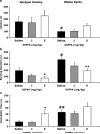Comparison of the kappa-opioid receptor antagonist DIPPA in tests of anxiety-like behavior between Wistar Kyoto and Sprague Dawley rats
- PMID: 20369354
- PMCID: PMC3370387
- DOI: 10.1007/s00213-010-1832-9
Comparison of the kappa-opioid receptor antagonist DIPPA in tests of anxiety-like behavior between Wistar Kyoto and Sprague Dawley rats
Abstract
Rationale: Recent evidence suggests a role for the dynorphin/kappa-opioid receptor (KOR) system in the expression of stress-induced behaviors. Wistar Kyoto (WKY) rats exhibit increased depression-like and anxiety-like responses in behavioral tests compared to other strains and may be a model of comorbid depression and anxiety characterized by increased activity within the dynorphin/KOR system. Though KOR antagonists produce antidepressant-like effects in WKY rats, their effects in tests of anxiety-like behavior have not been examined in the WKY strain.
Objective: The aim of the current study was to investigate the effects of the KOR antagonist 2-(3,4-dichlorophenyl)-N-methyl-N-[(1S)-1-(3-isothiocyanatophenyl)-2-(1-pyrrolidinyl)ethyl]acetamide hydrochloride (DIPPA) on the behavior of WKY rats and Sprague Dawley (SD) rats in tests of anxiety-like behavior.
Methods: The novelty-induced hypophagia and defensive burying tests were used to measure anxiety-like behavior in WKY and SD rats and determine the effects of DIPPA on anxiety-like behavior in both strains.
Results: WKY rats displayed greater amounts of anxiety-like behavior compared to SD rats. DIPPA produced anxiolytic-like effects in both tests in both strains.
Conclusions: WKY rats display more anxiety-like behavior at baseline compared to SD rats, and DIPPA produced anxiolytic-like effects in both WKY and SD rats. These findings support previous research suggesting that KOR antagonists possess anxiolytic-like properties and may potentially represent a novel class of treatments for mood disorders.
Figures


Similar articles
-
Antidepressant-like effects of kappa-opioid receptor antagonists in Wistar Kyoto rats.Neuropsychopharmacology. 2010 Feb;35(3):752-63. doi: 10.1038/npp.2009.183. Epub 2009 Nov 18. Neuropsychopharmacology. 2010. PMID: 19924112 Free PMC article.
-
Effects of the long-lasting kappa opioid 2-(3,4-dichlorophenyl)-N-methyl-N-[(1S)-1-(3-isothiocyanatophenyl)-2-(1-pyrrolidinyl) ethyl] acetamide in a drug discrimination and warm water tail-withdrawal procedure.Behav Pharmacol. 2005 Dec;16(8):665-70. doi: 10.1097/00008877-200512000-00010. Behav Pharmacol. 2005. PMID: 16286819
-
Anxiolytic-like effects of kappa-opioid receptor antagonists in models of unlearned and learned fear in rats.J Pharmacol Exp Ther. 2007 Dec;323(3):838-45. doi: 10.1124/jpet.107.127415. Epub 2007 Sep 6. J Pharmacol Exp Ther. 2007. PMID: 17823306
-
Role of kappa-opioid receptors in stress and anxiety-related behavior.Psychopharmacology (Berl). 2013 Oct;229(3):435-52. doi: 10.1007/s00213-013-3195-5. Epub 2013 Jul 9. Psychopharmacology (Berl). 2013. PMID: 23836029 Free PMC article. Review.
-
Kappa-Opioid Antagonists for Psychiatric Disorders: From Bench to Clinical Trials.Depress Anxiety. 2016 Oct;33(10):895-906. doi: 10.1002/da.22500. Depress Anxiety. 2016. PMID: 27699938 Free PMC article. Review.
Cited by
-
Targeting opioid dysregulation in depression for the development of novel therapeutics.Pharmacol Ther. 2019 Sep;201:51-76. doi: 10.1016/j.pharmthera.2019.04.009. Epub 2019 Apr 30. Pharmacol Ther. 2019. PMID: 31051197 Free PMC article. Review.
-
Kappa opioid receptor signaling in the basolateral amygdala regulates conditioned fear and anxiety in rats.Biol Psychiatry. 2011 Sep 1;70(5):425-33. doi: 10.1016/j.biopsych.2011.03.017. Epub 2011 Apr 30. Biol Psychiatry. 2011. PMID: 21531393 Free PMC article.
-
Ablation of kappa-opioid receptors from brain dopamine neurons has anxiolytic-like effects and enhances cocaine-induced plasticity.Neuropsychopharmacology. 2013 Jul;38(8):1585-97. doi: 10.1038/npp.2013.58. Epub 2013 Feb 27. Neuropsychopharmacology. 2013. PMID: 23446450 Free PMC article.
-
Naltrexone alters the processing of social and emotional stimuli in healthy adults.Soc Neurosci. 2016 Dec;11(6):579-91. doi: 10.1080/17470919.2015.1136355. Epub 2016 Jan 22. Soc Neurosci. 2016. PMID: 26710657 Free PMC article.
-
Dysfunctional Heteroreceptor Complexes as Novel Targets for the Treatment of Major Depressive and Anxiety Disorders.Cells. 2022 Jun 2;11(11):1826. doi: 10.3390/cells11111826. Cells. 2022. PMID: 35681521 Free PMC article. Review.
References
-
- Ahmadiyeh N, Churchill GA, Shimomura K, Solberg LC, Takahashi JS, Redei EE. X-linked and lineage-dependent inheritance of coping responses to stress. Mamm Genome. 2003;14:748–757. - PubMed
-
- Armario A, Gavalda A, Marti J. Comparison of the behavioural and endocrine response to forced swimming stress in five inbred strains of rats. Psychoneuroendocrinology. 1995;20:879–890. - PubMed
-
- Bechtholt AJ, Valentino RJ, Lucki I. Overlapping and distinct brain regions associated with the anxiolytic effects of chlordiazepoxide and chronic fluoxetine. Neuropsychopharmacology. 2008;33:2117–2130. - PubMed
-
- Bodnoff SR, Suranyi-Cadotte B, Aitken DH, Quirion R, Meaney MJ. The effects of chronic antidepressant treatment in an animal model of anxiety. Psychopharmacology (Berl) 1988;95:298–302. - PubMed
-
- Borsini F, Podhorna J, Marazziti D. Do animal models of anxiety predict anxiolytic-like effects of antidepressants? Psychopharmacology (Berl) 2002;163:121–141. - PubMed
Publication types
MeSH terms
Substances
Grants and funding
LinkOut - more resources
Full Text Sources
Medical

